Appendix VIII

Creative Engagements
The National Academies Keck Futures Initiative (NAKFI) conferences were unique. The meetings focused on providing a variety of venues for conversation and exploration. The foundation of this approach is participating in small groups charged with finding solutions to real-world, urgent problems. As part of a commitment to creating a memorable experience—and to inspire creative problem solving, collaboration, and innovation—in 2015 NAKFI for the first time introduced a variety of exhibitions, installations, and events that reflected the spirit of the gathering called Creative Engagements.
From the moment attendees arrived at the Beckman Center, they were exposed to experiences that defined the space as a place where something special would happen. The artists and creative practitioners who contributed to these creative engagements were also attendees. Their work reflects the variety of ways that people are crossing disciplinary traditions in the 21st century. Some installations were the result of collaborations among artists, scientists, and technicians that are both cultural and scientific in nature. Other installations were the result of new learning models where the individual practitioners have achieved advanced degrees and experience in both the sciences and the arts. The installations challenged perceptions of architecture, dance, fashion, and music while reflecting contemporary issues such as climate change, environmental conservation, nutrition, and health care and wellness.
The 2016 Futures Conference on Discovering the Deep Blue Sea employed a smaller offering of creative engagements focused specifically on the conference topic.
The creative engagements in the 2015 and 2016 Futures Conferences were organized in collaboration with the Cultural Programs of the National Academy of Sciences. Creative Engagement descriptions are reprinted as they appeared in the original conference materials.
CREATIVE ENGAGEMENTS AT THE 2015 FUTURES CONFERENCE
Brandon Ballengée
Love Motel for Insects: Viceroy Variation Maquette
Black lights, fabric, aluminum
2001-Ongoing
Loaned from IDEAS xLab, Louisville, KY
Brandon Ballengée is a visual artist, biologist, and environmental activist based in Louisiana. Ballengée creates transdisciplinary artworks inspired from his ecological field and laboratory research.
Love Motel for Insects is an ongoing series of public art installations intended to construct situations between humans and arthropods. The works use ultraviolet lights on enormous sculpted canvases to attract insects and create an opportunity for public interactions with nocturnal arthropods, which are not often seen. At each location, the Love Motels become the backdrop for community events.
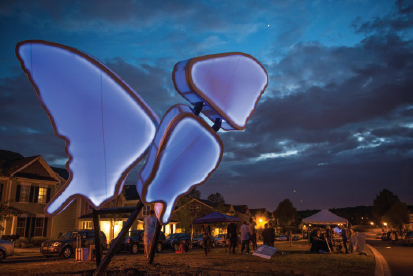
The Love Motels for Insects sculptures began in 2001 in Central America and variations have been installed in England, India, Ireland, Italy, Mexico, Scotland, and South Korea.
This Maquette was created for the 2013 Ideas Festival in Louisville, Kentucky.
Phillip Beesley
Untitled
Multi media
2014
Philip Beesley’s Living Architecture Systems Group (LASG) explores the possibilities of environments that possess qualities that come close to life—environments that can move, respond, and learn, and which are adaptive and empathic toward their inhabitants. These interactive environments integrate fine art, interactive media, protocell chemistry, distributed kinetics, and evolutionary control systems. The LASG explores a new generation of responsive spaces, raising fundamental questions about how architecture might behave in the future.
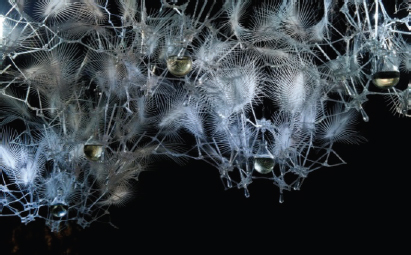
Akin to the functions of a living system, Beesley’s interactive geotextile mesh environments (see Hylozoic Series at www.philipbeesleyarchitect.com) include embedded machine intelligence that allows human interaction to trigger breathing, caressing, and swallowing motions and hybrid metabolic exchanges. In turn, these environments can acquire self-renewing, dynamically adjusting “learning” functions that resemble living systems of intelligence.
Katy Börner, Ying-Fang Shen, and Norbert Herber
Humanexus: Knowledge and Communication Through the Ages
Animation (12 min 33 sec)
World Premiere in USA, 2013; revised in April 2014
This semi-documentary animation visualizes human communication from the Stone Age to today and beyond. It aims to make tangible the enormous changes in the quantity and quality of our collective knowledge and the impact of different media and distribution systems on knowledge exchange. Humanexus: Knowledge and Communication Through the Ages was first shown publicly in early 2013 and has since garnered a number of awards from film festivals around the world.
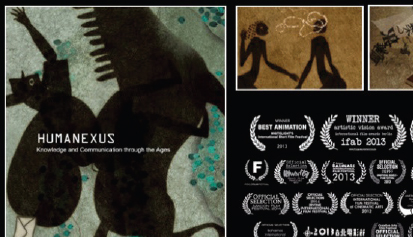
The work is a collaboration among Katy Börner, Professor of Engineering and Information Science at the School of Informatics, Computing, and Engineering at Indiana University (IU) and Director of the Cyberinfrastructure for Network Science Center; Norbert Herber, IU Department of Telecommunications senior lecturer and sound artist and musician; and Ying-Fang Shen, an artist and Assistant Professor at Virginia Commonwealth University.
A trailer of the film may be seen at http://yfshen.info/humanexus. The full film became freely available online at https://cns.iu.edu/humanexus as part of the conference.
Marc Bretillot and David Edwards
Le Whaf
2010
Invented by David Edwards, scientist, writer, and founder of Le Laboratoire, and designed by the culinary designer Marc Bretillot, Le Whaf is a sculptural object that generates clouds of flavor.
Le Whaf builds on Edwards’s work with biomedical transport systems, specifically pulmonary drug and vaccine delivery systems. Edwards followed his invention of Le Whif, a dry powder nutritional delivery system that delivers food into the mouth through the act of breathing, with Le Whaf, a modification of nebulizer technology used to deliver salt aerosols for bioaerosol mitigation by his startup company Pulmarix. It was born out of curiosity about whether the sensation of a Scotch or a chocolate cake or a coffee could be delivered to the mouth with almost no mass, no calories, no caffeine, or no alcohol.
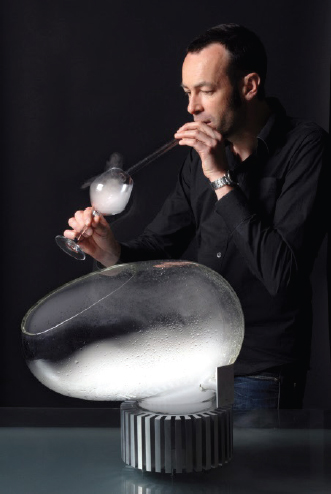
Le Whaf’s base is filled with piezoelectric crystals. When the machine is turned on, these crystals rapidly vibrate, creating ultrasoundwaves that transform liquids into clouds of tiny droplets that can then be breathed into the mouth and savored through a glass straw. Eating habits have been changing since the beginning of time, including smaller and more frequent “meals.” In a very real way, Le Whaf is a natural trend in the evolution of cuisine.
Niccolò Casas
Black Turbulence
3D printed polyamide
2013
Italian architect and professor Niccolò Casas is currently a Ph.D. candidate at The Bartlett University College London and a faculty member at the Rhode Island School of Design. Inspired by entropy phenomena that cause design to arise and evolve in nature as patterns, his work aspires to capture beauty in its mutable state and inevitable decline. His research highlights the convergence of architecture, art, and fashion design via the application of emergent digital technologies and additive manufacturing.
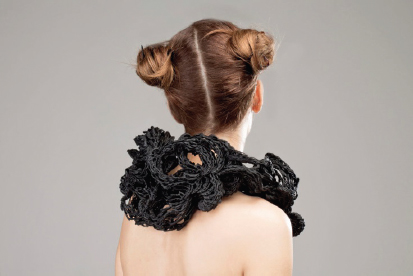
Black Turbulence is about the simulation of a fractured system in which the whole decomposes making singularities emerge. It concerns the process of fragmentation of a system of relations and it is the expression of the corrupted complexity generated by simple iterations.
Black Turbulence is a 3D printed necklace by Niccolò Casas and Leyre Valiente. The necklace is part of a two-piece collaboration—Turbulence and Black Turbulence—presented at the Mercedes Benz Fashion Week in Madrid in March 2013 and part of the Leyre Valiente collection Malleus Maleficarum.
David Edwards, Rachel Field, and Don Zereski
Goldilocks and the Three Bears: The Smelly Version
oBook
2014
The oBook Goldilocks and the Three Bears: The Smelly Version retells the classic story with the help of the oPhone, a device that emits different scents at key points in the story. Like Goldilocks, you will be searching for—and eventually finding—a smell that is just right.
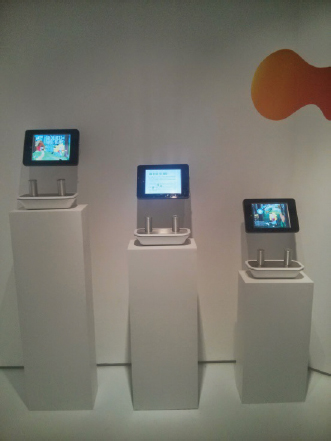
The oPhone was created as part of a platform of devices and accompanying apps that empower users to digitally communicate with scent. The applications for the oPlatform range from olfactive tweets and storytelling to use for health care diagnostics.
The oNotes app empowers users to record, share, and relive moments with a new level of sensorial clarity; they take a photo, tag the associated smells, and save or share with others. With the aid of an oPhone, they can play back the olfactive moment whenever they choose.
Ken Goldberg, Sanjay Krishnan, and Yiming Jen
Internet
2015
Ken Goldberg is an artist, writer, inventor, and researcher in the field of robotics and automation. He is the Craigslist Distinguished Professor of New Media at the University of California (UC), Berkeley. Sanjay Krishnan is a Ph.D. student at UC Berkeley.
In this Internet-based earthwork, live ground motion along the Hayward Fault in California is detected by a seismograph and transmitted
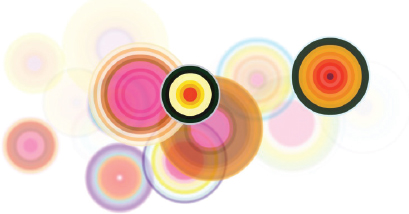
continuously to mobile devices to generate a dynamic visual field inspired in part by Harold Edgerton’s stroboscopic photography.
Contributors include Fernanda Viégas, Martin Wattenberg, David Nachum, Vijay Vasudevan, Muriel Maffre, Ben Pierce, Yuri Possokhov, Randall Packer, Gregory Kuhn, Woj Matusek, and others who collaborated on companion works. Thanks also to JoAnne Northrup and Catharine Clark and Rick Rinehart for insights and Richard Allen, Doug Neuhouser, and Peggy Hellweg of the UC Berkeley Seismological Laboratory for the live data feed.
http://bloomcanvas.parseapp.com
Dan Goods and David Delgado
Anthony White—Technical integration
Refraction
Theater light, water, custom electronics
2014
Pasadena-based artist and designer Dan Goods is the Visual Strategist for NASA’s Jet Propulsion Lab (JPL). At JPL, he leads a team developing creative ways of communicating and working to transform complex concepts into meaningful stories that can be universally understood. His work has been seen in public spaces, art museums, and in outer space.
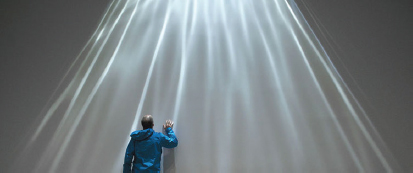
Refraction is the altering of the direction of a wave due to a change in its transmission medium. In the development of early telescopes, refraction played an important role and occupied the efforts of scientists such as Isaac Newton who were curious about the properties of light. The refracting telescope tamed the physics of bent light by the
creation of a lens that caused its rays to converge together on a focal point. In this installation, the opposite happens—the beauty of untamed waves of light intersecting with rowdy waves of water are allowed their expressive chaos and feral subtleties.
http://www.directedplay.com/refraction
Carol LaFayette, Director, Institute for Applied Creativity
André Thomas, Director, LIVELab
Schaefer Mitchell, M.S. candidate
Fermi Niveditha Pramananda Perumal, M.S. candidate; Department of Visualization, Texas A&M University
Interactive Conference Roster
App and touch screen
2015
A simple mobile app nudges you into making connections with other attendees. Through play, you map a sentence to a dance, gesture, or motion to be combined with your visual images into a conference avatar. Guided by intelligent matchmaking with IBM’s Watson, the project creates the condition for encounters that may spark collaboration. At the conference, all connections were combined into a work of art.
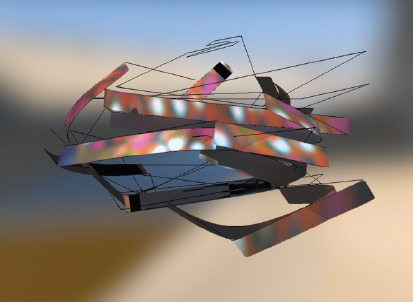
Liz Lerman
Ask a Question
Dance/performance
2015
Liz Lerman is a choreographer, performer, and writer. She founded the Liz Lerman Dance Exchange in 1976 and won a MacArthur “Genius Grant” Fellowship in 2002. She left the Dance Exchange in 2011 and now works as an independent artist.
From a piece about her days as a go-go dancer into a recent investigation of origins that included putting dancers in the tunnels of the Large Hadron Collider at CERN, she has spent the past four decades making her artistic research personal, funny, intellectually vivid, and up to the minute. A key aspect of her artistry is opening her process to various publics from shipbuilders to physicists, construction workers to ballerinas, resulting in both research and outcomes that are participatory, relevant, urgent, and usable by others. Lerman developed her process over decades of creative research through multidisciplinary works including her recent “science trilogy”: Healing Wars (2014); The Matter of Origins (2011, with support from the National Science Foundation); and Ferocious Beauty: Genome (2006), created in collaboration with dozens of geneticists and educators, exploring how knowledge of the genome changes the way we think about aging, perfection, ancestry, and evolution.
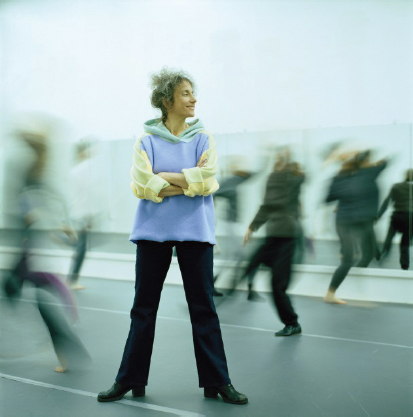
Lerman develops artistic tools to aid in translating ideas, creating thinking grids, and creative problem solving. During the 2015 Futures Conference, she engaged attendees in a movement experiment designed to foster creativity and collaboration.
Using movement and inquiry in a collaborative framework allows our physical selves to contribute to knowledge and comprehension in surprising ways. This particular activity harnesses several different creative processes to connect ideas to gesture and then translate back again into new information about a subject, our histories, and the contributions of others.
Robyn Metcalfe
Food Tracking
2015
Robyn Metcalfe is a historian, desert distance runner, food futurist, editor, and publisher of Food+City (FC), formerly known as the Food Lab at The University of Texas at Austin.
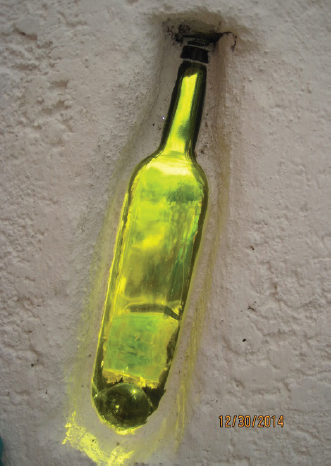
FC is a platform for bold exploration of the global food system. It raises awareness of the opportunities for improvement in our food systems and uncovers insights that will shape how we make our world sustainable. The platform explores how food moves around the world; the surprising complexity of distribution; how politics, economics, and trade create (and thwart) food crises; and much more.
During the 2015 Futures Conference, and in collaboration with the Beckman Center culinary staff, Metcalfe raised awareness of the food we eat through a “food tracking” exercise. Attendees made hypotheses about the origins of each ingredient in the food on their plates—inspiring a deeper understanding of how science and art, culture and technology, and history and innovation are necessary to feed the world.
Andrea Polli
Sonic Antarctica
Audio
2007/2008
As an artist, Andrea Polli researches and creates artwork about global systems and their effects on individuals and communities. Her work Sonic Antarctica features natural and industrial field recordings, sonifications, and audifications of science data and interviews with weather and climate scientists on the continent. The areas recorded include: the “Dry Valleys” (77°30’S 163°00’E) on the shore of McMurdo Sound, 3,500 km due south of New Zealand, the driest and largest relatively ice-free area on the continent completely devoid of terrestrial vegetation. Another is the geographic South Pole (90°00’S), the center of a featureless flat white expanse, on top of ice nearly 1.7 miles thick.
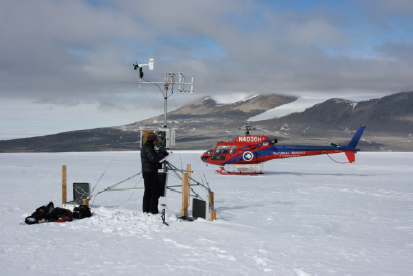
Credit: Andrea Polli.
She has worked in collaboration with atmospheric scientists to develop systems for understanding storm and climate information through sound, a process called sonification. Polli’s projects often bring together artists and scientists from various disciplines.
CREATIVE ENGAGEMENTS AT THE 2016 FUTURES CONFERENCE
Brandon Ballengée
RIP African Pompano and RIP Bluntnose Stingray from the series Ghosts of the Gulf
Digital chromogenic prints on handmade Japanese paper 2013–2014
Permanent collection of the National Academy of Sciences
On display in the Atrium
Brandon Ballengée’s Ghosts of the Gulf print series are made from scans of chemically cleared and stained specimens collected in the Gulf of Mexico after the 2010 Deepwater Horizon oil spill. These species and numerous others may be in decline. The prints are meant to be seen as apparitions. The chemical process of clearing and staining specimens involves multiple steps, revealing the complex architectural anatomy of these beautiful species. Although the images look like brightly colored X-rays, Ballengée actually scanned each chemically altered specimen millimeter by millimeter to make detailed recordings. He then assembled the layers in Photoshop to create the final artworks.
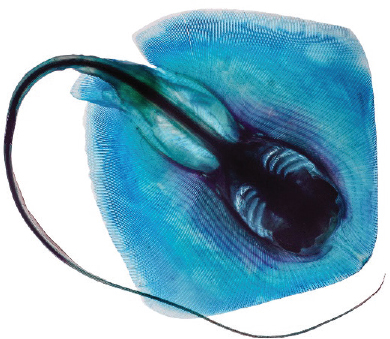
Ballengée is a visual artist, biologist, and environmental activist based in Lafayette, Louisiana. He creates transdisciplinary artworks inspired from his ecological field and laboratory research. Since 1996, a central investigation focus has been the occurrence of developmental deformities and population declines among amphibians. He is a Postdoctoral Research Associate, Museum of Natural Science, Louisiana State University, Baton Rouge, studying the impact on fish species from the 2010 Gulf of Mexico oil spill with Curator of Fishes Prosanta Chakrabarty. Their project, Crude
Life Portable Museum: A Citizen Art and Science Investigation of Gulf of Mexico Biodiversity After the Deepwater Horizon Oil Spill, is ongoing thanks to an Interdisciplinary Projects Grant Award from NAKFI. A mid-career retrospective of his work opened in the fall of 2016 at the University of Wyoming Art Museum, Laramie, which will travel to the Missoula Art Museum, Missoula, Montana; the Nevada Museum of Art, Reno; the Herbert F. Johnson Museum of Art, Cornell University, Ithaca, New York; and the Acadiana Center for the Arts, Lafayette, Louisiana.
Philip Beesley
Sentient Chamber (documentation)
Archival ink jet print
2016
Permanent collection of the National Academy of Sciences
Documentary photograph on display in the Atrium
Sentient Chamber was an interactive installation on view at the National Academy of Sciences, Washington, DC, from November 2015 through May 2016. This experimental cross-disciplinary work drew from ideas about next-generation lightweight structures, interactive distributed computation, and synthetic biology to imagine a possible future of architecture.
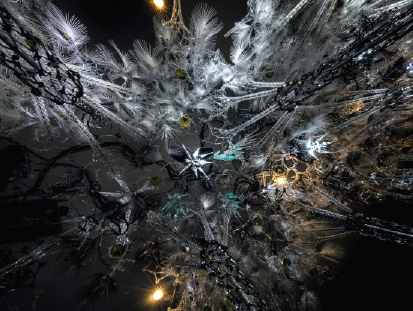
The installation was created by Philip Beesley and his Toronto-based Living Architecture Systems Group (LASG). Beesley and LASG explore the possibilities of environments that possess qualities that come close to life—environments that can move, respond, and learn and which are adaptive and empathic toward their inhabitants.
Students from several Washington, DC-area universities, including The Catholic University of America School of Architecture and Planning; Gal-
laudet University Department of Art, Communication, and Theatre; Johns Hopkins University Master of Arts in Museum Studies; and Virginia Tech School of Architecture + Design, provided installation assistance.
Mark Dion in collaboration with Lisa-ann Gershwin
The Trouble with Jellyfish
On display during the conference in the Executive Dining Room
In recent years, jellyfish have gained notoriety for wreaking havoc as they multiply en masse for unknown reasons. These population explosions—what are known as blooms—cause wide-scale destruction of human systems by clogging power plants, capsizing fishing boats, and decimating fish populations. Their ability to thrive where other species are struggling also means that jellyfish routinely obliterate fragile ecosystems by causing dead zones and a lack of dissolved oxygen underwater. While these troubles are beginning to garner public attention, what to do about them remains unclear. Understanding why, when, and where jellyfish blooms will appear is still not well understood, and past population control measures have not been effective on a large scale.
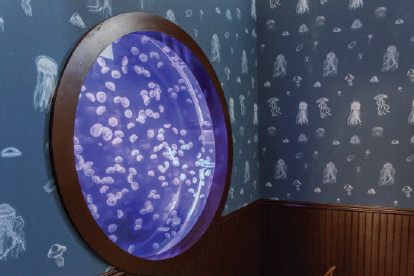
The Trouble with Jellyfish, an exhibition by contemporary artist Mark Dion in collaboration with marine biologist Lisa-ann Gershwin, offers a cultural immersion into the stunning world of the jellyfish and an exploration of how their activities affect the fate of our oceans. In conceptualizing this experiment, Dion worked closely with students from Le Laboratoire founder David Edwards’s class “How to Create Things and Have Them Matter” taught at Harvard’s John A. Paulson School of Engineering & Applied Sciences. In spring 2014, 22 Harvard University students from widely varied academic concentrations began to think about marine biological challenges associated with jellyfish. They continued working through summer 2014 with Dion, Edwards,
and Gershwin in Cambridge, Massachusetts; France; and South Africa to explore the habitat and circumstances of jellyfish blooms and to devise creative solutions to the wealth of problems that have sprung up amid the population explosion of these astonishing invertebrates. Some of the dream designs from this class appear in The Trouble with Jellyfish.
Dion is a contemporary artist whose work examines the ways in which dominant ideologies and public institutions shape our understanding of history, knowledge, and the natural world. He has received numerous awards, including the ninth annual Larry Aldrich Foundation Award (2001). He has had major exhibitions at the Miami Art Museum (2006); the Museum of Modern Art, New York (2004); the Aldrich Contemporary Art Museum, Ridgefield, Connecticut (2003); and the Tate Gallery, London (1999).
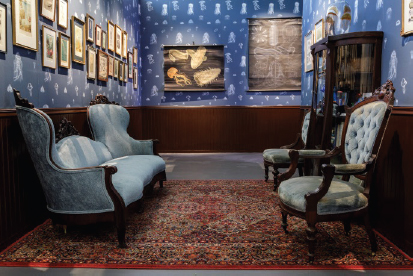
Gershwin is a biologist based in Launceston, Tasmania, specializing in the study of jellyfish and the species’ adverse effect on marine ecosystems. Gershwin has described more than 200 species of jellyfish and developed a system to predict blooms of the hazardous Irukandji jellyfish in North Queensland. In 2013, Gershwin released Stung!: On Jellyfish Blooms and the Future of the Ocean, a book describing the diversity and adaptability of jellyfish and their increasing numbers at the expense of other organisms worldwide.
Susan Middleton
Lion’s Mane Jelly (Cyanea capillata) from the series Spineless
Archival pigment print
2014–2016
Permanent collection of the National Academy of Sciences
On display in the Atrium
The lion’s mane jelly is the world’s largest jellyfish species, its bell reaching a diameter of 3 feet or more. Like all jellyfish, it is a carnivore feeding on planktonic animals that drift into its curtain of tentacles, which can stretch for several meters. The tentacles (relatively short in the juvenile seen here) arise from eight crescents along the bell’s margin and are armed with batteries of stinging cells. When an unsuspecting animal brushes against the cells, it triggers the release of sticky or poisonous filaments that entangle and subdue the animal. On a diet of animal plankton, small fish, and other jellies, the lion’s mane jelly grows quickly, reaching its adult size in less than 1 year.
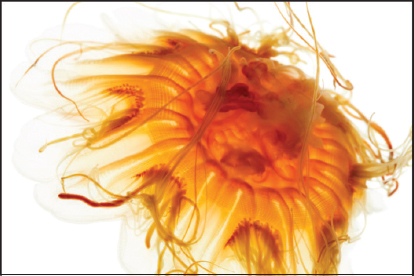
This photograph is from Spineless, Susan Middleton’s series exploring the mysterious and surprising world of marine invertebrates, which represent more than 98% of the known animal species in the ocean. Middleton is a San Francisco–based photographer who specializes in the portraiture of rare and endangered animals, plants, sites, and cultures. Her work has been exhibited worldwide in fine art and natural history contexts and is in the collection of the National Gallery of Art, Washington, DC. She was awarded a Guggenheim fellowship in 2009.
This page intentionally left blank.


















